— by Margie Doyle —
Last week, Orcas Recycling Services (ORS) Board President Tim Blanchard and Executive Director Pete Moe gave local press a tour of property off Shaeffer Stretch on the east side of Crow Valley, and discussed its feasibility as a site for a re-born Exchange..
It’s been just over a year since ORS took over operations of the Transfer Site from San Juan County, and along with garbage transfer, compliance with county regulations, transfer site rehabilitation and other “normal” operations, the ORS board has had more than one antennae tuned to the re-birth of the Exchange. Moe says, “It has been foremost since the beginning to get the Exchange back in place… still, we had things we had to get done first to keep the transfer station operating.”
The Exchange was a … well, a historic, popular bartering site, placed in a small substandard shack and stretching out under the trees just west of the transfer station scales on property owned by the county. In 2013, the Exchange burned to the ground. Later that year, the non-profit Orcas Recycling Services, which had run the Exchange with volunteers, was awarded the contract to lease and operate the county transfer site. This award came after ORS board had cleaned up the property, taxes and regulations under which both the Exchange and the Transfer Site had operated for decades.
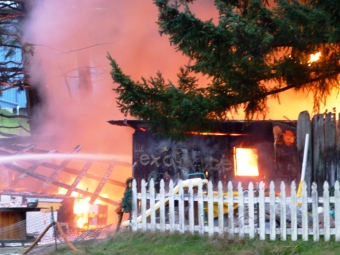
Orcas Exchange burned to the ground in February 2013. Photo use only with permission of orcasissues.com
Recently, ORS signed a contract to purchase the 35-acres owned by Bill Carlson, pending a feasibility study. That study will analyze the financial and regulatory elements, including renovations and rehabilitation of property and structures, operations, regulations concerning permits, land use and building codes.
Blanchard said “I hope to move through the feasibility process right away and determine shortly after the beginning of the year if the [Carlson] site is workable.’
“If not, we would be disappointed, but we already have contingency plans in place on the transfer station site.” However, there are a number of things that would have to be changed at the old [transfer station] site to be in compliance with the county. Chief among those elements is construction of a road on the transfer station property, which will require engineer, road grading and permits. The road would need to be installed before a new Exchange building could be constructed.
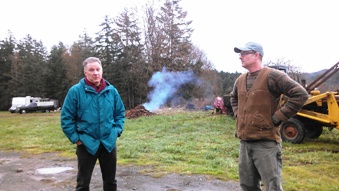
Tim Blanchard and Pete Moe consider the feasibility of the Carlson acreage for an ORS/Exchange site.
And the property would still be owned by the county and leased to ORS for use by the community, while the proposed site would be conducive to the renewable product, “zero-waste” goals of the ORS, Moe and Blanchard said.
“The ORS board has been asked to ensure the Exchange for generations to come. We believe there is a sound basis and the [Carlson] structure and property could work. It’s a very sound project, in the best interests of the Exchange and the community to rehabilitate this parcel.” said Blanchard.
The county-leased Transfer Station site would continue to operate for waste transfer and also for other recycling projects. Pete Moe says, “There is a community need to go back and self-sort [garbage and recycling]. Now it is all mixed together and it is better economically and environmentally” to sort the waste stream.
The exact amount of acreage at the Carlson site is to be determined through the permitting process. The front, western, part is zoned non-conforming commercial and is where the replacement structure for the Exchange is located. The building is now used as a boat repair facility, with room for offices. It also has utilities; an important consideration as the Transfer Station site doesn’t have water. The large amount of area that is covered is also a key advantage of the existing building.
The back portion of the acreage is zoned agricultural, and as such would serve handily for long- range ORS projects such as composting, mulching and animal husbandry. “We’d create good pasture and improve the watershed in cleaning up the property,” said Moe.
Should the feasibility study recommend going ahead with the purchase, the broadly-outlined steps are:
- fundraise to acquire the property;
- renovate the building to code;
- clean up the property;
- obtain permits and comply with regulations;
- open the New Exchange
“We’ve not gotten distracted from re-establishing the Exchange; and think we’ve found a way to put the Exchange back and fulfill the mission of the ORS — to move ahead to a zero-waste environment,” said Moe.
ORS Board members are Larry Coddington, John Forrest, Michael Greenberg, Kate Hansen, Ian Harlow, Susan Malins, Bruce Rylander, and Wendy Shinstine.
**If you are reading theOrcasonian for free, thank your fellow islanders. If you would like to support theOrcasonian CLICK HERE to set your modestly-priced, voluntary subscription. Otherwise, no worries; we’re happy to share with you.**

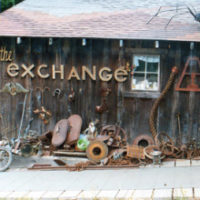
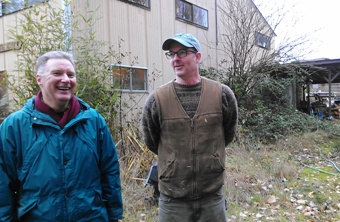
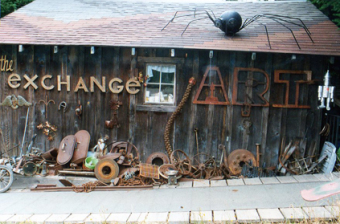







The Board’s decision to attempt to buy land for the “New Exchange” seems counter-productive to the homegrown Idea of the Exchange. A new Exchange should not be separated from the Transfer Station site. When the old Exchange went up in flames I remember thinking that once the debris was cleared out we could put up a big metal building on the property to take the old one’s place. That wouldn’t cost nearly as much as purchasing property for the Exchange to begin again and quickly. Alas, we humans seem to have a penchant for complicating everything. The Dollar seems to be hyper inflating. Not a good time to spend more money on an Exchange that could easily be operational at the old site and adhere to its’ Original purpose.
I LOVE the idea of the Exchange having it’s own permanent home and the Carlson property seems like a good fit. I’m excited about the ideas that ORS is generating for how to take the Exchange into its next chapter of vibrancy – and how it will contribute to the sustainability and self-sufficiency of our community. We have sorely missed the utility of the Exchange – and the social activity of visiting with island neighbors over a good find. Even my relatives are visiting less often without the promise of an exciting visit to the magical treasure hunt of Exchange! Really.You have my support.
Hi all–To address the many questions regarding Orcas Recycling Service’s plans for rebuilding the Exchange, ORS has scheduled a community Q&A this Sunday, December 7th, from 5-7pm at the Eastsound Fire Station. See you there!
As one of those cast of characters with a 20 year association with the exchange and in my own humble opinion , The Exchange as we knew it will never return , Those days of overt noncompliance have ended.In My heart I would love to see the exchange re-evolve from its ashes yet a new location is in line with what I wanted to see happen with the exchange
Dear ORS
You are a committee
A Camel is a horse designed by a committee
Be careful
Lanny Robertson